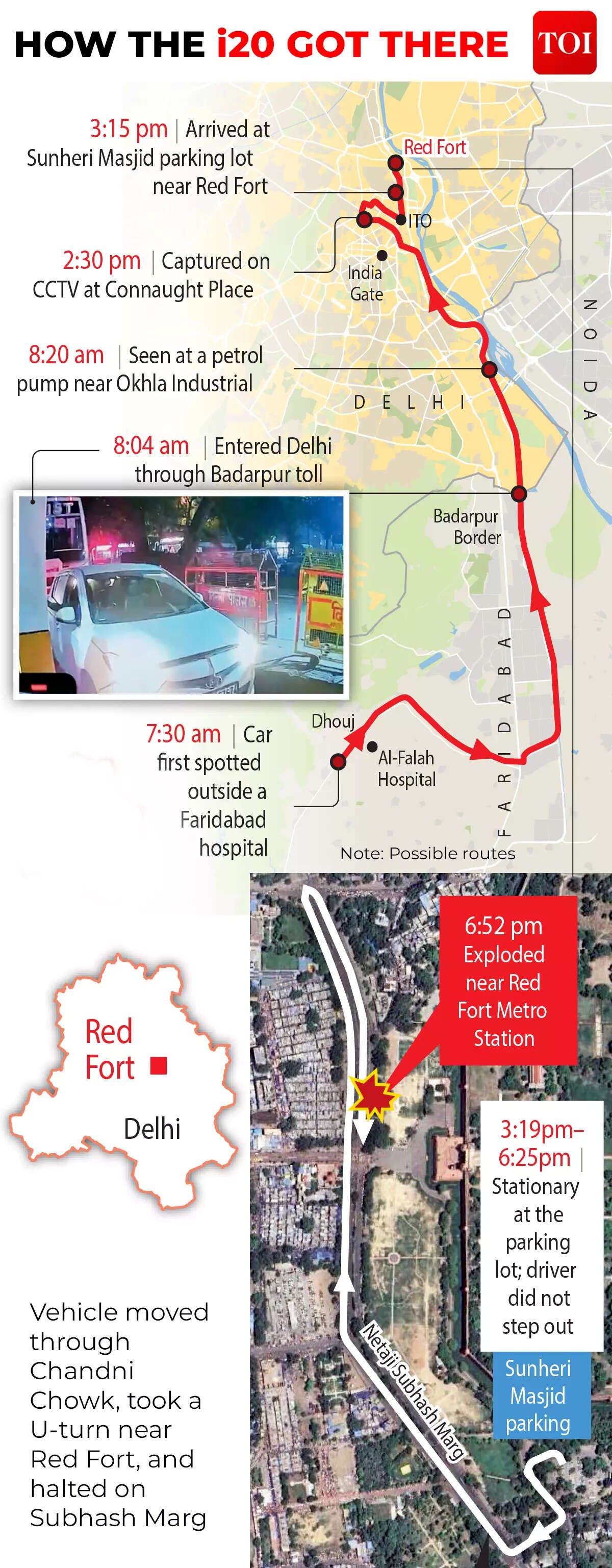ARTICLE AD BOX

For nearly 16 hours, Umar drove across NCR, avoiding known routes, in a frantic attempt to evade surveillance and possibly destroy evidence.
NEW DELHI: It was meant to be a “spectacular strike” — a multi-city series of vehicle-borne IED attacks planned meticulously for months by a terror module led by two young doctors from Al-Falah University.
But when Jammu & Kashmir Police and Haryana counterparts raided a Faridabad hideout and seized nearly 350kg of explosives, the plan began to unravel. Within hours, Dr Umar Un Nabi — a key member of the cell — was on the run.What followed was a 16-hour panic drive that ended in one of Delhi’s most chilling explosions in recent years — a fiery blast near the Red Fort metro station that killed Umar himself with 13 others and exposed a larger, international terror network.The bust that triggered a chain reaction
The Faridabad raid, which resulted in the arrest of Umar’s associate Dr Muzammil Ganaie, was the turning point. Investigators said the two had stockpiled explosives since 2022 — enough to assemble over 50 high-impact IEDs — and had conducted reconnaissance of Delhi landmarks earlier this year.As news of Muzammil’s capture spread, Umar panicked. Sources said he left his Al-Falah University quarters abruptly, loading the Hyundai i20 with a concealed IED before fleeing toward Delhi.
For nearly 16 hours, he drove across NCR, avoiding known routes, reportedly in a frantic attempt to evade surveillance and possibly destroy evidence.

The explosive end near Red FortBy the evening, the white i20 rolled into Old Delhi — one of the most crowded and historically sensitive areas of the capital. What happened next is captured on CCTV: a brief slowdown in traffic, a flash, then a deafening explosion that turned the car into a fireball.Investigators later confirmed that the severed arm found near the wreckage matched Umar’s DNA. The IED had detonated prematurely — either due to mishandling or a panic-triggered mechanism — ending Umar’s life and setting off a nationwide counterterror probe.A transnational plot with Turkish linksOfficials have since revealed that Umar and Muzammil’s radicalisation and training were part of a broader plot hatched in Turkiye in 2022. Umar, who had travelled to Ankara that March, was reportedly acting under instructions from a handler codenamed “Ukasa”, linked to Jaish-e-Mohammed and Ansar Ghazwat-ul-Hind.Their communications began on Telegram and later shifted to encrypted apps like Signal and Session, where they received directives for attacks timed around symbolic national events.Investigators now believe the group had procured three vehicles — the i20, a red Ford EcoSport, and a Maruti Brezza — to carry out sequential blasts across Delhi and Ayodhya. While the i20 exploded, the EcoSport was traced to Faridabad; the Brezza remains missing.Missed targets and the December 6 plotSources said the group was preparing for another attack on December 6, part of a series that could have stretched into Republic Day 2026. The module, according to investigators, had even planned a symbolic strike in Ayodhya during a religious flag-hoisting ceremony later this month.That timeline, however, collapsed after the Faridabad bust. With his network falling apart and surveillance tightening, Umar’s desperate flight became his final act — one that inadvertently foiled a far deadlier series of attacks.The aftermathThe discovery of Umar’s role has deepened the investigation into the “white coat terror” cell — a group of seemingly ordinary professionals who turned to extremist ideology. Agencies are now questioning multiple staffers from Al-Falah University and tracking money trails possibly linked to foreign handlers.An officer summed it up grimly: “Umar’s death ended one link, but it also exposed how close we came to multiple coordinated blasts. His 16-hour drive was not just an escape — it was the last chapter of a plan years in the making.”

 1 hour ago
6
1 hour ago
6








 English (US) ·
English (US) ·